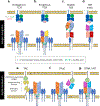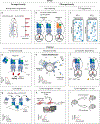T cell receptor therapeutics: immunological targeting of the intracellular cancer proteome
- PMID: 37891435
- PMCID: PMC10947610
- DOI: 10.1038/s41573-023-00809-z
T cell receptor therapeutics: immunological targeting of the intracellular cancer proteome
Abstract
The T cell receptor (TCR) complex is a naturally occurring antigen sensor that detects, amplifies and coordinates cellular immune responses to epitopes derived from cell surface and intracellular proteins. Thus, TCRs enable the targeting of proteins selectively expressed by cancer cells, including neoantigens, cancer germline antigens and viral oncoproteins. As such, TCRs have provided the basis for an emerging class of oncology therapeutics. Herein, we review the current cancer treatment landscape using TCRs and TCR-like molecules. This includes adoptive cell transfer of T cells expressing endogenous or engineered TCRs, TCR bispecific engagers and antibodies specific for human leukocyte antigen (HLA)-bound peptides (TCR mimics). We discuss the unique complexities associated with the clinical development of these therapeutics, such as HLA restriction, TCR retrieval, potency assessment and the potential for cross-reactivity. In addition, we highlight emerging clinical data that establish the antitumour potential of TCR-based therapies, including tumour-infiltrating lymphocytes, for the treatment of diverse human malignancies. Finally, we explore the future of TCR therapeutics, including emerging genome editing methods to safely enhance potency and strategies to streamline patient identification.
© 2023. Springer Nature Limited.
Conflict of interest statement
Competing interests:
C.A.K. and S.S.C. are inventors on patents related to TCR discovery and public neoantigen-specific TCRs and are recipients of licensing revenue shared according to MSKCC institutional policies. C.A.K. has consulted for or is on the scientific advisory boards for Achilles Therapeutics, Affini-T Therapeutics, Aleta BioTherapeutics, Bellicum Pharmaceuticals, Bristol Myers Squibb, Catamaran Bio, Cell Design Labs, Decheng Capital, G1 Therapeutics, Klus Pharma, Obsidian Therapeutics, PACT Pharma, Roche/Genentech and T-knife. C.A.K. is a scientific co-founder and equity holder in Affini-T Therapeutics. B.M.B. is an inventor on patents related to TCR engineering and neoantigen discovery, has consulted for Eureka Therapeutics and EnaraBio, and is on the scientific advisory board of T-cure Bioscience. S.A.Q is an inventor in patents related to the use of T cell therapies targeting tumour clonal neoantigens in cancer. S.A.Q. is also a founder, CSO, and equity holder of Achilles Therapeutics. A.R. reports personal fees from Amgen, Chugai, Genentech, Merck, Novartis, Roche, Sanofi, Vedanta, 4C Biomed, Appia, Apricity, Arcus, Highlight, Compugen, ImaginAb, Kalthera/ImmPACT Bio, MapKure, Merus, Rgenix, Lutris, Nextech, PACT Pharma, Synthekine, Tango, Advaxis, CytomX, Five Prime, RAPT, Isoplexis, and Kite/Gilead and has received grants from Agilent and Bristol Myers Squibb outside the submitted work.
Figures



References
-
-
Hedrick SM, Cohen DI, Nielsen EA & Davis MM Isolation of cDNA clones encoding T cell-specific membrane-associated proteins. Nature 308, 149–153 (1984).
Together with reference , these papers report the genetic sequence for the TCRβ chain in mice and humans for the first time.
-
-
- Yanagi Y, et al. A human T cell-specific cDNA clone encodes a protein having extensive homology to immunoglobulin chains. Nature 308, 145–149 (1984). - PubMed
Publication types
MeSH terms
Substances
Grants and funding
LinkOut - more resources
Full Text Sources
Other Literature Sources
Medical
Research Materials

